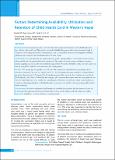Please use this identifier to cite or link to this item:
https://hdl.handle.net/20.500.14356/1704Full metadata record
| DC Field | Value | Language |
|---|---|---|
| dc.contributor.author | Paudel, K P | - |
| dc.contributor.author | Bajracharya, D C | - |
| dc.contributor.author | Karki, K | - |
| dc.contributor.author | K C, A | - |
| dc.date.accessioned | 2023-05-19T05:20:01Z | - |
| dc.date.available | 2023-05-19T05:20:01Z | - |
| dc.date.issued | 2016 | - |
| dc.identifier.citation | PaudelK. P., BajracharyaD. C., KarkiK., & CA. K. (2016). Factors Determining Availability, Utilization and Retention of Child Health Card in Western Nepal. Journal of Nepal Health Research Council, 14(2). https://doi.org/10.33314/jnhrc.v14i2.797 | en_US |
| dc.identifier.issn | Print ISSN: 1727-5482; Online ISSN: 1999-6217 | - |
| dc.identifier.uri | http://103.69.126.140:8080/handle/20.500.14356/1704 | - |
| dc.description | Original Article | en_US |
| dc.description.abstract | Abstract Background: The immunization card is revised with addition of general information about child health and is later called as child health card. This card is a tool used by Health Management Information System in Nepal. It is important for tracking the records of immunization. Aim is to identify the factors determining the availability, utilization and retention of the child health card in Western Nepal. Methods: A cross sectional study was conducted among mothers having children < 24 months old from Gorkha (Western Hill) and Nawalparasi (Western Terai) districts. The sample size for the study was 600 and systematic random sampling was used to select the mothers having less than 24 months old children. Data entry and analysis was done by using SPSS. Qualitative data was analyzed by making matrix. Results: The average age of respondents was 24 years. The majority of respondents have gained higher level education. Retention of the card was found to be 82.2%. 90.3% retention was seen among 0-12 months children age group whereas it was 74 % among12 to 24 months age group. The reasons for less retention were torn by the child/played by child (54.6%) followed by lack of proper place,unaware about importance and poor quality of card.The new child health cards were insufficient, compelling use of both new and old cards which created problem in consistency. Regarding utilization of child health card, it was found to be used for birth registration and for further studies in abroad. Conclusions: The areas of utilization of child health card should be broadened so that the retention of card can be increased. The main reasons for less retention of the card are torn by children and lack of the proper place. Keywords: Availability; retention; utilization; vaccination card. | en_US |
| dc.language.iso | en | en_US |
| dc.publisher | Nepal Health Research Council | en_US |
| dc.relation.ispartofseries | May-Aug, 2016;797 | - |
| dc.subject | Availability | en_US |
| dc.subject | Retention | en_US |
| dc.subject | Utilization | en_US |
| dc.subject | Vaccination card | en_US |
| dc.title | Factors Determining Availability, Utilization and Retention of Child Health Card in Western Nepal | en_US |
| dc.type | Journal Article | en_US |
| local.journal.category | Original Article | - |
| Appears in Collections: | Vol. 14 No. 2 Issue 33 May-Aug 2016 | |
Files in This Item:
| File | Description | Size | Format | |
|---|---|---|---|---|
| 797-Article Text-1475-2-10-20170528.pdf | Fulltext Download | 199 kB | Adobe PDF |  View/Open |
Items in DSpace are protected by copyright, with all rights reserved, unless otherwise indicated.
